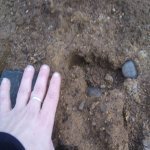I'm going to have to disagree with most everything you said. You're rooting your argument in the separation of sasquatch DNA and human ... and you're almost certainly dead wrong. The reason is hybridization which almost certainly requires them to have 23 chromosome pairs, same us us, for viable hybrids, not "mules". That necessarily puts them vastly closer to us than they are to other known living primates. We can't cross with chimps, gorillas, etc. At least in Native American lore, we do indeed cross with sasquatch.
I will agree that our known ancestors and "cousins" like Denisovans are likely closer to us than sasquatch, but I'm betting they're still Homo, not Pan or Gorilla. In the examination of DNA from the environment, that's too close to separate with e-DNA. Probably like blacktailed deer and mule deer, mulies being a more recently developed subspecies and the parent of both being nearly identical to the current Sitka blacktails. The difference is more visible in physical morphology than it is testable in genetics, especially with tests that focus on cursory differences rather than deeper differences.
We may just have to agree to disagree. You're not going to convince me because I'm right and I'm not going to convince you because you're stubborn. One of the pluses to solving the puzzle is putting many of these old debates to rest once and for all.
The bottom line is, I think, we can use e-DNA to home in on an area to search, but to actually discover bigfoot, we're going to have very fresh nuDNA, not just mtDNA, and we're going to have to have the cash to do the full genome test, not just a superficial test, and at least for me, that means absolute certainty about what the sample is.
MIB



